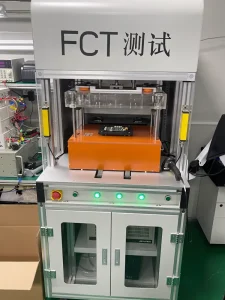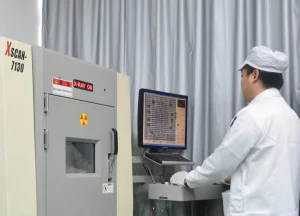We are all concerned about the quality of any product we purchase. Sometimes, we prefer quality over price. PCB manufacturing quality control is no exception.
Quality control refers to the entire process of ensuring the best operational PCBs. Wherever your PCB moves during production, maintaining the utmost quality is crucial. For example, when assembling the PCB components, controlling the dust is one of the quality control measures.
Why is PCB manufacturing quality control so important? Since PCBs are the backbone of every electronic device, their durability is of great importance. How do you ensure the long-lasting performance of your PCB? You can ensure it in two ways. First, you can ensure professional PCB manufacturing. Second, you can provide regular maintenance of the electronic device.
However, about 90% of the durability depends on how you make your PCB. Here comes the importance of maintaining the PCB manufacturing quality controls. A professional PCB manufacturer, like UETPCB, ensures several quality control measures. In this article, you will go through some of the most critical quality control measures used in PCB manufacturing.
Importance of PCB Manufacturing Quality Control
Quality control in PCB manufacturing is mainly necessary for efficiency and reliability. We can divide the PCB manufacturing quality control into two main sections. First are the proper manufacturing quality control measures. This one involves maintaining the professional manufacturing of PCBs. This type of measure consists of following the standards.
The second is through the testing and inspection process. This way, you can assess the quality of your PCB and take the necessary steps to make any necessary adjustments. Both ways are vital for making high-performance boards. Here are four fundamental reasons why quality control is so important:
#1 Preventing Potential Defects and PCB Failures
Proper quality control helps you identify and reduce any issues during production. For example, you can easily find soldering faults, misalignments, or short circuits. When you know these defects early, you can take the necessary steps to prevent them. This way, you can save time and potentially avoid unnecessary investments.
#2 Ensuring High-Quality PCB
A high-quality PCB manufacturer consistently adheres to strict quality standards. From design to assembly, the company will assist you in solving errors to avoid delays. They ensure ISO and IPC compliance for a better-quality experience.
UETPCB provides all this flexibility to perform better in the market. This practice helps them achieve around 5000+ reliable customers worldwide.
#3 Improve Product Durability and Reliability
With the proper tests, you can finally find out the quality of your PCB. A good PCB maker always keeps the right tools for quality control in the QC department. X-rays, AOI, and various other useful testing devices are among the most essential tools.
#4 Cost and Time Efficiency
Proper PCB manufacturing quality controls also reduce rework and material waste. When everything goes smoothly, you won’t experience any delivery delays. This way, you can keep production on schedule and within budget. Therefore, selecting a high-quality PCB manufacturer, such as UETPCB, is a crucial step.
Ways of Quality Control in PCB Manufacturing
As mentioned, quality control in PCB manufacturing can be divided into two sections. However, checking for the specifications and defects is the most important one here.
Concerning defects, your PCB may experience various issues. Some focus on the surface, while others look deeper inside. These tests help identify and resolve problems early. Below are some standard and effective quality control methods used in the industry.
#1 Visual Inspection
Visual inspection is the most basic one. Professionals or experts check the assembly standards, which are visible to the naked eye.
You can do it either manually or by automated testing. Manual inspection refers to a process in which you perform an examination with the naked eye or with the aid of a magnifier. You can check the placement of each component. You can also check bridges, scratches, and soldering. It helps you catch problems before they are discovered during other inspections.
#2 X-ray Inspection
X-ray inspection is a non-destructive method for testing PCBs. It lets you check hidden defects without causing any damage.
X-ray inspection works similarly to BGA, which is invisible to the naked eye. This method utilizes X-rays to examine the interior of the boards and layers. You can use it to identify problems with bridging, misconnection, solder joints, and other issues.
X-ray testing also helps you identify errors that are difficult to detect and provides a clear inside view.
#3 Electrical Testing
Electrical testing, also known as e-testing, is a crucial process for PCB manufacturing. It is the most critical step of PCB’s functional testing.
Electrical testing helps you verify all the equipment on the boards. It involves ICT, fixture tests, and bed-of-nails testing. In this way, you can check capacitors, resistors, shorts, or other components. Besides, you may also justify the wiring and electrical properties of the board.
#4 Optical Inspection
Optical inspection provides the opportunity to inspect everything using a camera and software. This process operates quickly with higher accuracy. There is also no chance of missing errors. For this reason, most people prefer it for large-scale productions.
#5 Microscopic Inspection
It is also an inspection process, but at the microscopic level. The method utilizes a microscope or other tools to examine the board closely. Using it, you can find tiny cracks, alignments, or broken traces. Overall, the process ensures the correct formation of each item to ensure proper function.
#6 Flying Probe Testing
Flying Probe is an automated testing system. A computer-controlled probe flies over the PCBs, allowing you to go through each point on the board. Thus, you can detect short circuits, wrong connections, and other functional problems. Flying probe testing is one of the most crucial tests in PCB manufacturing quality control.
Tips for PCB Quality Control
For PCB Manufacturing Quality Control, follow the design and check the file before production. Select every raw material and observe it. Confirm that manufacturers provide AOI, visual, and electrical testing in each step. It will help you achieve the best results. Additionally, you must select skilled staff and ensure a consistent standard of quality. If there is any problem, address it quickly and work with trusted makers. Regarding this, we will provide you with some tips that can help you ensure your PCB’s improved quality control.
Standards for PCB (IPC A 600)
The conditions that a PCB should meet are outlined in IPC 600. Following the IPC-A-600 standard, you can produce high-quality PCBs. It includes inspection, board levels, and improvement phases. Overall, the standard shows the acceptable and unacceptable features of PCBs. When choosing a maker, ensure they are IPC-A-600 compliant.
Component Sourcing and Expertise
In this step, you will assess the manufacturer’s expertise in component sourcing. It refers to the process of sourcing reliable and appropriate parts for PCBs. Ensure that the company sources its components either directly or through third-party suppliers. It’s a crucial step to avoid counterfeit products and ensure projects are completed on time with optimal functionality.
Bill of Materials Checking
After component sourcing, the Bill of Materials (BOM) is the third critical step. It’s a comprehensive process of reviewing the parts you select for your PCB. An accurate BOM also provides cost estimation and ensures you are using the correct parts. Therefore, ensure that the maker can provide you with an accurate BOM report for your PCB.
Solder Quality and Test
If everything has gone according to plan so far, then you should proceed with soldering and testing capabilities. The company must provide necessary documentation about the soldering and functional testing. Additionally, the products underwent testing, including dip-and-look, wetting balance, and SMT simulation tests.
PCB Manufacturing Process Controls
This is a procedure for controlling the entire manufacturing operation. From choosing materials to manufacturing printed circuit boards, it oversees practically everything. Generally, the manufacturer must offer a one-stop solution for PCB Manufacturing Quality Control. So, choose a company that ensures advanced quality controls in production.
PCB Manufacturing and Assembly Checks
Both manufacturing and assembly checks are essential. The manufacturing check involves the quality control of the PCB itself. These checks primarily involve drilling, plating, etching, and other processes. On the other hand, assembly checks involve functional tests of various components. Therefore, we always recommend choosing a maker that handles both methods with high expertise.
Testing Facility and Certifications
The company you are choosing must undergo several testing steps. This way, you can ensure that the products you are making meet high-quality standards. Additionally, the factory must be equipped to address errors or mistakes with advanced solutions. Are there any facilities for environmental testing? How about stress tests? How about others that your project often experiences?
Moreover, verify whether the company holds certifications from recognized organizations such as IPC, ISO, UL, or IATF. These standards mainly illustrate PCB quality and safety concerns. Above all, it fosters trust, security, and a sense of following strict rules.
Summary
Creating and maintaining the quality of PCBs is a significant challenge. Not every manufacturer can do this together. If you want flexibility and reliability, choose a reputable manufacturer.
Throughout this article, we tried to discuss everything you should know when making PCBs. The steps mentioned above will help you maintain the quality of your PCB.
If you have any further questions about this topic, please don’t hesitate to contact us. You can ask questions and seek help at any time.



